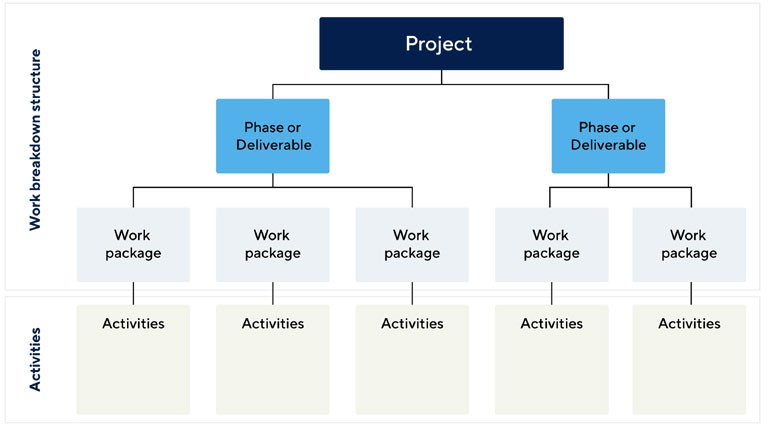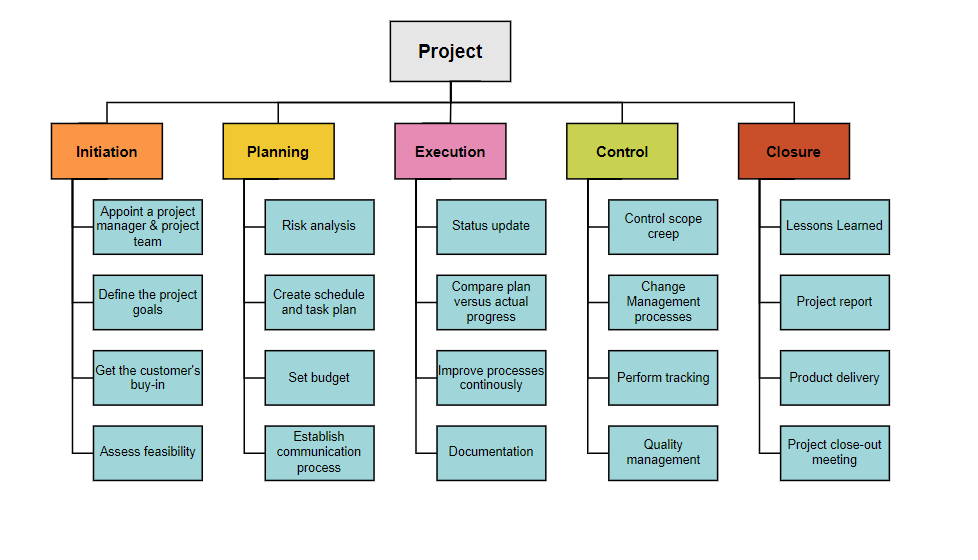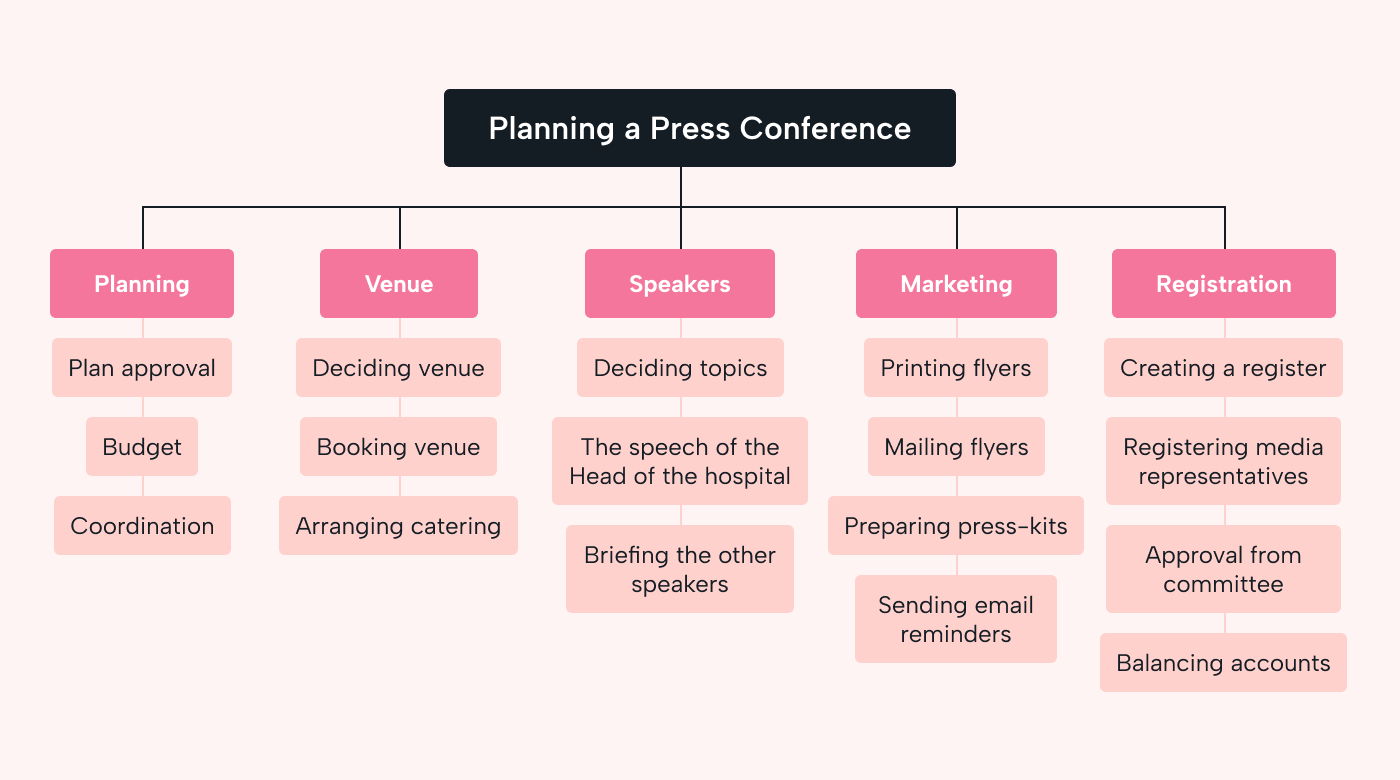Work Breakdown Structure: What is it? & How To Make?
When tackling a project, it’s crucial to have a clear roadmap. That’s where a Work Breakdown Structure (WBS) comes in. This project management tool helps define and structure your project activities, making the process more manageable.
The WBS can be structured in three typical ways: phase-based, deliverable-based, or responsibility-based. This means you can organize your project based on phases, agreed deliverables, or the organization units working on the project. The flexibility of WBS makes it a go-to tool for project managers.
Beyond just WBS, there are other types of breakdown structures, too. These include Resource Breakdown Structure (RBS), Risk Breakdown Structure, and Organization Breakdown Structure (OBS). Each serves a unique purpose, providing a hierarchical decomposition of resources, risks, or organization units.
What is the Work Breakdown Structure?

You may be wondering: “What exactly is this work breakdown structure we’re talking about?” Besides being one of the most crucial tools in project management, a Work Breakdown Structure (WBS) is a hierarchical chart that breaks down the whole project into manageable chunks. It helps you to have a clear roadmap to guide your team to the finish line smoothly and successfully. Standardizing the project’s tasks through a work breakdown structure in project management maintains focus, improves efficiency, and increases project success rates.
Key Characteristics and Components of the WBS
The WBS showcases its true strength in its core attributes: being deliverable-oriented and a leveled hierarchical decomposition of work. It’s visceral and deliberately deliverable-oriented. That means it’s aligned and focused on what has to be produced to complete a process, phase, or project.
Thus, the WBS helps you to structure project activities based on the agreed outputs from the project. Another fundamental peculiarity of a WBS is the hierarchical breakdown of work. Each level in the WBS breaks down the project into finer detail, making the project more manageable. This hierarchical decomposition provides a clear path for project managers to follow, ensuring control and easy supervision.
Take, for example, a work breakdown structure for a new website project:
- The first level (Level 1) might be “Website for New Brand.”
- Level 2 could break that down into “Secure website URL, Design layout, Develop content.”
Each subsequent level continues to break down the deliverables to the most minor possible tasks, paving way for easy task allocation and tracking. This simplified approach to dividing work makes the use of a work breakdown structure template, an extremely walkable path. You will find this tool of immeasurable value when navigating the world of project management.
And remember, if you’re keen on creating your own work breakdown structure example to suit your specific project needs, it’s important to note that the WBS has no one-size-fits-all. Whether you need to structure your WBS based on phases, deliverables, or responsibilities, there’s flexibility to tailor it to your project’s unique requirements.
What Is a Work Breakdown Structure in Project Management?

Work breakdown structure (WBS) is a comprehensive, hierarchical model of the tasks needed to complete a project. The structure ensures that no single task is overlooked, making it a functional roadmap for a project’s completion. But how do you generate a work breakdown structure? Let’s take a look at an example of a work breakdown structure.
A reliable method to create a WBS is to start by defining your highest-level objectives, typically the project’s final deliverable. Then, you break this down into the main deliverable-based, phase-based, or responsibility-based segments, depending on your project’s requirements. As an established project management tool, the WBS methodology eases the task delegation and tracking process, simplifying project management for you and your team.
Along with WBS, three other critical project management tools share the breakdown structure concept, including:
- Resource Breakdown Structure (RBS)
- Risk Breakdown Structure
- Organization Breakdown Structure (OBS)
What Are the Uses and Purposes of Work Breakdown Structures?
When it comes to project management, having a dynamic Work Breakdown Structure (WBS) can significantly enhance the productivity of your operation.
- A WBS serves as the backbone of your project, outlining crucial tasks required for project completion.
- It’s tailored to fulfill specific, high-level objectives and leverage resources more efficiently.
- A WBS is about delivering outcomes. It’s a tool to define the main project deliverable expressed in smaller components.
- A template can automate the creation of a new project while enabling real-time tracking and reporting on progress.
- A WBS helps you monitor progress throughout all phases of a project.
- Robust online planning tools take your WBS and elevate it.
Here’s a quick summary of WBS purposes in project management:
- Organizing and defining project scope
- Enhancing project efficiency and operation
- Monitoring progress and making real-time adjustments
- Keeping the venture on schedule
- Facilitating accurate reporting on progress and performance
These are methods that can significantly boost your project’s performance and contribute towards a successful outcome. Therefore, understanding the value of a work breakdown structure in project management is undoubtedly essential.
How To Create A Work Breakdown Structure?

Creating a work breakdown structure (WBS) might seem overwhelming, especially if you’re new to project management. But don’t worry; we’re here to walk you through the process step by step.
1. Understand the Project’s Scope
When starting any project, understanding its scope is paramount. Without having a clear picture of all the project’s dimensions, making a detailed work breakdown structure would be nearly impossible. Begin with a thorough reading of the project scope statement. It’ll provide you with detailed insights about what’s expected from the project. Further, a well-defined project scope management plan is your map on how to deal with any changes that might affect your deliverables.
2. Determine Major Deliverables
In the scenario of building a house, you have three essential deliverables: the foundation, exterior, and interior. And these are not just any deliverables. These are major deliverables, each falling under the responsibility of a separate team. Applying the same logic to your project, identify the larger tasks that are indispensable for project completion. Each of these major deliverables should ideally form a separate level in your work breakdown structure.
3. Determine Work Packages
This part is critical and requires input from your entire project team and stakeholders. After identifying your major deliverables, the next step in creating your work breakdown structure (WBS) is to pin down your work packages. A work package is basically a smaller task that fits into your larger deliverable. It is also the lowest level of your WBS and paves the essential path to accomplish the larger deliverables.
4. Create a WBS Dictionary
A work breakdown structure isn’t just an outline of work packages. It’s also a comprehensive guide that includes significant details such as project information, budgets, milestones, risks, boundaries, and project owners. Thus, along with your WBS, ensure you’ve got a detailed WBS dictionary that covers these areas in-depth, too.
5. Use the Right WBS Format
The right WBS format is crucial for the success of your project because it adds clarity and prevents confusion. While structuring your work breakdown, consider factors such as the complexity of the project and distinguish between the deliverables, major deliverables, and work packages to ensure your WBS is easily understandable by everyone involved.
What is Work Breakdown Structure Template?

The use of a Work Breakdown Structure Template can be beneficial in automating the creation process, making real-time tracking and progress reporting easier. Moreover, using project management software that provides this template can help in managing work, monitoring progress, and providing critical project data for decision-making.
Remember to constantly tailor the template according to the specifics of your project to ensure it serves its purpose effectively. It should not only include all your deliverables and work packages but also clearly outline the path to meet your project objectives.
Types Of Work Breakdown Structures: Deliverable-Based vs Phase-Based
When crafting a Work Breakdown Structure, understanding the different types can truly alter your project’s trajectory. In the realm of project management, there’s a clear distinction between a Deliverable-Based WBS and a Phase-Based WBS.
Deliverable-Based Work Breakdown Structure
In a Deliverable-Based WBS, your primary focus is on the end product or service – the ultimate goal of the project. This approach is ideal when the final output’s features and benefits have been clearly defined. Here, you’ll organize your project tasks based on the major deliverables. Each task is a stepping stone towards that final product, ensuring that every component contributes to the overall objective.
Remember: Structuring your WBS around deliverables can streamline execution and make success tangible.
Phase-Based Work Breakdown Structure
On the other hand, a Phase-Based WBS is centered on your project’s life cycle stages. These could range from initiation and planning to execution, monitoring, and closure. Rather than directly focusing on the project’s end result, this approach emphasizes each phase and its corresponding tasks.
With a Phase-Based approach, every phase of your project becomes a work package, creating a timeline of tasks that lead to successful completion. It’s ideal for projects where processes and timelines overshadow the final deliverable’s importance.
How To Create a WBS in Project Management Software?

Project management software provides various tools to ensure you can effectively set up a work breakdown structure (WBS) for your project. While each software has unique capabilities, the essentials of creating a WBS remain the same.
By Creating Top Level Project Task
Begin by creating a top-level project task for the WBS within your selected PM software. Depending on the software and specific project, this top-level task typically represents the main deliverable or overarching project goal, acting as a cornerstone for the subsequent breakdown.
Leveraging the functionality of specialized PM software makes this task both straightforward and flexible. Features such as drag-and-drop functionality and automated WBS generation help to simplify the process, especially for those new to WBS creation.
By WBS Templates
Some software options offer WBS templates, which can be further customized to suit your project needs. These templates serve as a robust foundation, helping you craft a well-done WBS even if you’re a beginner. Let’s talk about using these templates. Imagine you’ve chosen project management software that provides a free 30-day trial. You can upload a work breakdown structure template into it, and this action automatically creates a new project in the software. Now you’re all set to plan, schedule, monitor, and report on your project.
By Cloud Based Software
The advantage of cloud-based software is that all your data, including your WBS, is collected and displayed in real time. This dynamic interaction between the WBS and the various online planning tools enhances the efficiency of your project management process.
Certain work breakdown structure examples in your chosen project management software can further guide you. These examples provide firsthand insight into practical applications of WBS in different scenarios, allowing you to grasp the concept better and effectively apply it to your project.
Conclusion
So, you’ve seen how integral a Work Breakdown Structure is to effective project management. Whether it’s phase-based, deliverable-based, or responsibility-based, the right WBS approach can streamline your project stages. It’s a tool with roots in the 1960s, standardized by the Project Management Institute, and it’s been transforming project management ever since. Today, you can leverage project management software to create your own WBS with ease. Top-level tasks, drag-and-drop features, and WBS templates are at your disposal. Plus, cloud-based software provides real-time data collection and seamless integration with other planning tools. It’s not just about understanding the theory but also about applying it practically. And with software capabilities and WBS examples, you’re well-equipped to implement an effective WBS in your next project.
Frequently Asked Questions
Q1. What is a Work Breakdown Structure (WBS)?
A Work Breakdown Structure (WBS) is a project management tool that helps in understanding and organizing the work required to produce a project’s deliverable(s).
Q2. How does a phase-based WBS differ from a deliverable-based WBS?
While a phase-based WBS is preferable for projects with defined stages, a deliverable-based WBS is recommended for handling intricate, complex projects.
Q3. What is the historical background of WBS?
The development of WBS dates back to the 1960s, and its standardization was carried out by the Project Management Institute in 1987.
Q4. How can you create a WBS using project management software?
Project management software aids in creating a WBS by using top-level tasks, drag-and-drop features, and WBS templates for project planning. Cloud-based software enhances the process through real-time data collection and integration with planning tools.
Q5. What is the role of a responsibility-based WBS?
A responsibility-based WBS delegates tasks in accordance with organizational units, ensuring that every aspect of the project is assigned to and managed by the appropriate team or individual.
Q6. Can WBS examples in a software tool help in practical implementation?
Yes, WBS examples, especially those provided in a software tool, can aid in the practical application of the work breakdown structure, guiding you on how to leverage specific software capabilities for effective WBS implementation.
Q7. What are the benefits of using a WBS?
Creating a WBS imparts a clear understanding and organization of the work required for the project. It ensures better resource allocation, cost estimation, risk identification, and ultimately, project success.

Leave a Reply